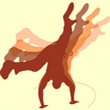Monday, 6 August 2012
Our Mirror Neurons Prefer the Movements We’ve Already Learned
 Often I use this blog to talk about the latest studies in neuroscience. But this week I want to talk about a study that was conducted a few years back, because it provides a good introduction to the brain cells known as mirror neurons, which are often described as strange entities indeed.
Often I use this blog to talk about the latest studies in neuroscience. But this week I want to talk about a study that was conducted a few years back, because it provides a good introduction to the brain cells known as mirror neurons, which are often described as strange entities indeed.
Mirror neurons were first identified in the motor area of the frontal cortex of monkeys, by Italian neurophysiologist Giacomo Rizzolatti, in the early 1990s. Rizzolatti discovered that these particular neurons became activated not only when monkeys made a hand gesture or a facial expression (as is normal for motor neurons), but also when monkeys watched other monkeys doing so, without making the gesture or expression themselves (hence the name “mirror neurons”).
Many subsequent studies have tended to confirm that mirror neurons exist in the human brain as well. For example, in a study published in the December 2004 on-line edition of Cerebral Cortex, a group of professional ballet dancers and a group of dancers of capoeira (a Brazilian dance/martial arts form) were asked to watch short videos of dancers performing brief ballet and capoeira moves, while a functional magnetic resonance imaging (fMRI) scanner detected changes in their brain activity. A control group of non-dancers also participated.
The fMRI results showed that the areas of the dancers’ brains associated with this “mirror neuron system” were more active when they were watching movements of the kind that they were trained in than when they were watching the other kind. The non-dancers in the control group showed even less mirror-neuron activity than the ballet dancers watching capoeira or the capoeira dancers watching ballet, and this lower level of activity was the same regardless of which of the two types of dance they were watching.
This study thus not only supports the idea that there is a mirror neuron system in the human brain, but also shows that this system’s activity level increases with the degree of training that the individual has in certain particular types of movements. And, it should be stressed, this increased activity occurs not in the visual centres of the occipital cortex, but in the motor area where the brain plans complex movements, as well as in the intraparietal sulcus, a brain area responsible for visual-motor integration.
Thus it is the brain areas associated with body movement that respond differently to the sight of movements depending on whether these movements are part of the individual’s personal repertoire. Which, when you think about it, makes these mirror neurons far less strange and potentially highly useful for many other functions, communication and socialization being two that are cited frequently in the literature.
![]() Daniel Glaser’s Latest Study with Ballet and Capoeira Dancers
Daniel Glaser’s Latest Study with Ballet and Capoeira Dancers
![]() Interview with Daniel Glaser
Interview with Daniel Glaser
![]() Action Observation and Acquired Motor Skills: An fMRI Study with Expert Dancers
Action Observation and Acquired Motor Skills: An fMRI Study with Expert Dancers
Body Movement and the Brain | Comments Closed







